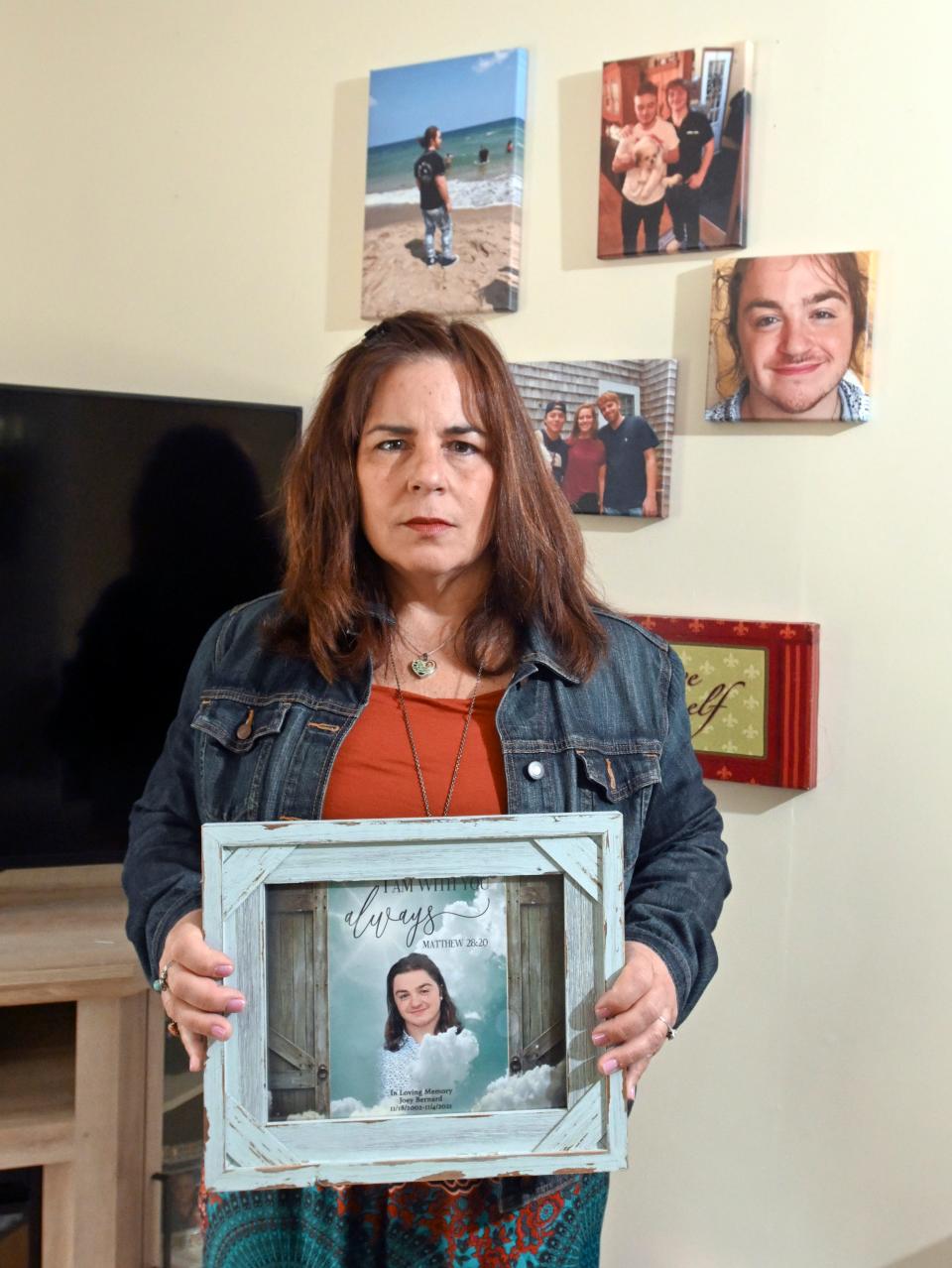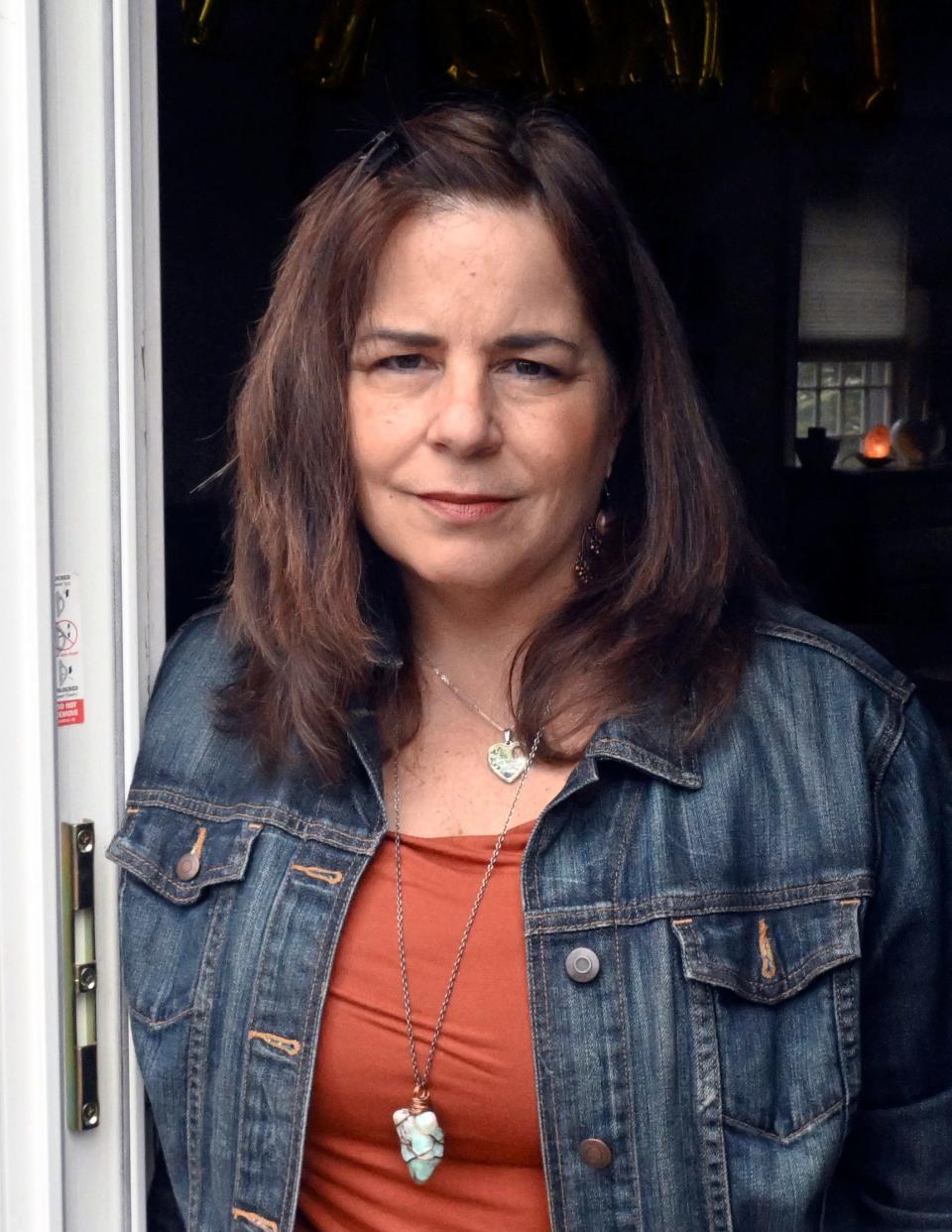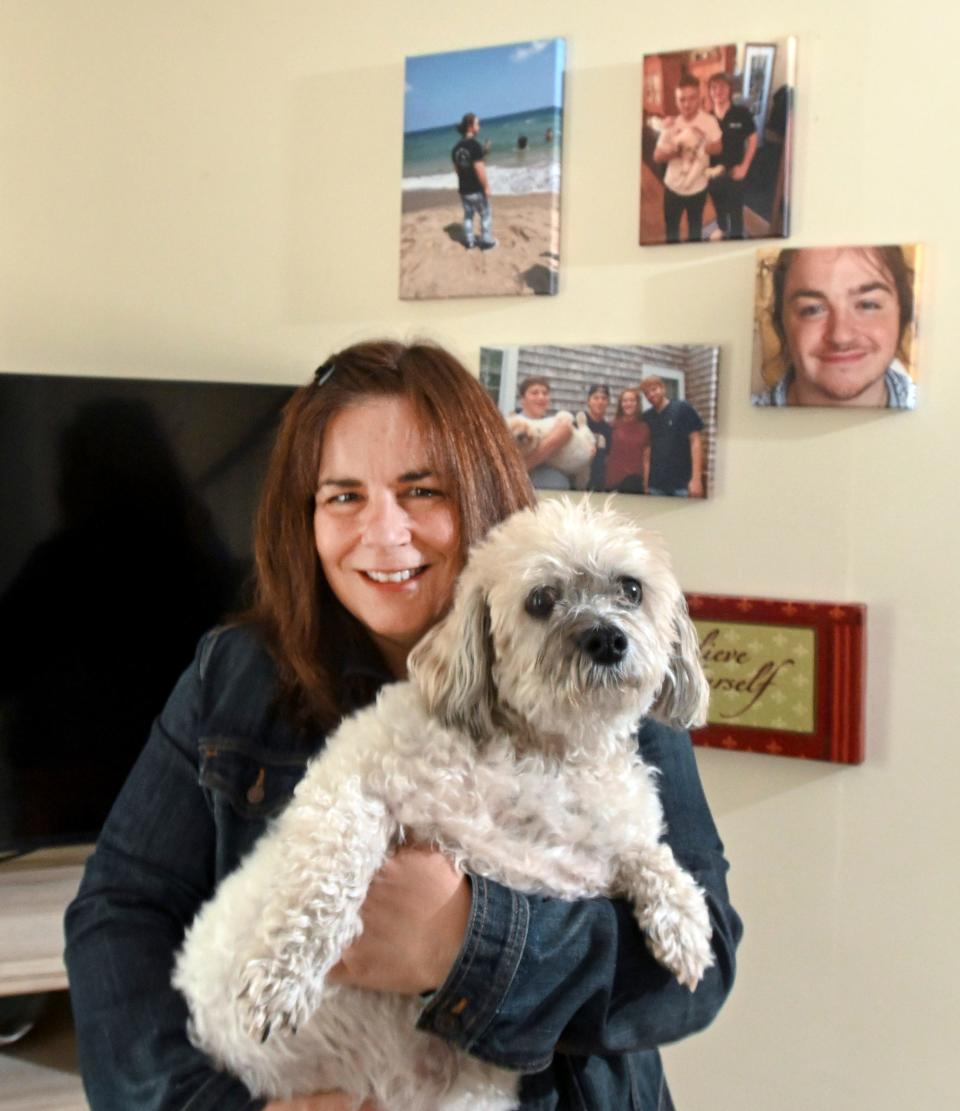A new synthetic opioid makes its way across the U.S., already killing one Cape Cod teen
When Jill Maiorana's son Joey Bernard died at age 18 in November from a drug overdose, she assumed fentanyl took his life.
But when Maiorana, of North Falmouth, received the toxicology report in March, she was shocked to find that Bernard actually died from a drug called N-pyrrolidino etonitazene — a synthetic opioid 20 times more potent than fentanyl.
As she read the report, Maiorana slowly unfurled conversations she'd had with Bernard, who had been seeking treatment in Florida and was living in a sober house at the time.
"My son was days away from celebrating his six-month sobriety date," she said.
The news also prompted Maiorana to open Bernard's email account — which had recorded history of Joey looking to buy Percocet. The realization of what happened to her son slowly sunk in.

"The drug he received was a powerful drug — it was disguised in pill form," Maiorana said. "He thought he was buying a Percocet. That's what he thought he was getting and it took his life."
Once she received the confirmation of the drug in Bernard's system, Maiorana began warning other parents who have children that are also suffering from addiction. She said she's uncertain if N-pyrrolidino etonitazene is making its way to Cape Cod.
"This is the awareness that I want to get out there. Addiction can be anyone's son, daughter, sister, brother, mother or father," Maiorana said. "It could even be college kids at a party without a history of addiction that end up losing their lives to something laced."

How prevalent is N-pyrrolidino etonitazene?
Alex Krotulski, a toxicologist and director of the Center for Forensic Science Research & Education, said new synthetic opioids have evolved into one of the fastest growing groups of new pyschoactive substances worldwide. N-pyrrolidino etonitazene, specifically, was first detected in May 2021, after toxicology work was conducted during an overdose case in West Virginia, Krotulski said.
Since then, N-pyrrolidino etonitazene also appeared during death investigations in Pennsylvania, New York, Florida and Colorado, he said. Additionally, synthetic opioids were reported by agencies in Europe.
More: Parents Supporting Parents: Auction to fund substance use disorder treatment program
"We’ve seen it in a few hundred deaths in our lab — it's really all over," Krotulski said. "N-pyrrolidino etonitazene is the most prevalent of lower level synthetical opioids that we're seeing. At this point, it's possible that it's in every state."
Wilson Compton, a physician and deputy director of the National Institute on Drug Abuse, said the National Drug Early Warning System sent out an alert in April about a syringe that was found in a Washington and Baltimore high intensity drug trafficking area. The hypodermic needle contained fentanyl and isotonizazene, a structurally similar compound to N-pyrrolidino etonitazene.
In the same time frame, the Early Warning System also released a bulletin identifying isotonitazene in the Washington and Baltimore region, with 17 cases in Maryland and two incidents in Washington.
"We don't have evidence that N-pyrrolidino etonitazene has reached New England," Compton said. "But we do have evidence from other parts of the country beyond Florida."
Fentanyl now dominates the recreational drug market
Although the recreational drug market was once dominated by heroin, Krotulski said fentanyl now leads the synthetic opioid supply and makes up 90% to 95% of what's sold on the street. The rest of what's being sold are other synthetic opioids like N-pyrrolidino etonitazene.
"Heroin is gone — it's pretty much all fentanyl flooding the market at this point," he said. "It (fentanyl) started infiltrating the opioid supply in 2008 so it is kind of a long hauler and it's probably not going anywhere."
More: Opinion: A letter to Cape kids and their parents. Please share this widely.
The presence of synthetic opioids like N-pyrrolidino etonitazene "rise and fall like a rollercoaster," said Krotulski.
"You've got one that pops up then it goes away and then another one pops up and then it goes away," he said.
The most dangerous thing about these substances, he said, are potency levels.
"Fentanyl itself is already more potent than heroin so it's a little bit scary when we are seeing all of these synthetic opioids that are stronger than fentanyl," he said. "The one that scares me the most is N-pyrrolidino etonitazene because it's so highly potent."
Synthetic opioid labs dominate in the Far East
Although Maiorana doesn't know who sold N-pyrrolidino etonitazene to Bernard, Krotulski said the drug is coming from countries such as China and India and making its way to street-level dealers.
The Times attempted to contact the Cape Cod & Islands Drug Task Force multiple times by phone and email about the local presence of N-pyrrolidino etonitazene. A task force media representative answered initially but no information was provided.
Compton agreed that most drug synthesis is happening in the Far East, but said laboratories are moving closer to the United States.
“What my colleagues in law enforcement are letting us know, is that those manufacturing techniques have been imported to laboratories in Central and possibly South America. We're seeing new locations for manufacturers.”
More: Hyannis brothers plead guilty to drug and gun charges
While Compton said he can't speak to N-pyrrolidino etonitazene specifically, he said manufacturers around the world are creating fentanyl and other synthetic opioids with “backup chemistry” infrastructure, including laboratories.
“If you took organic chemistry in college or observed some of those classrooms, it's that kind of equipment you would need to manufacture fentanyl or fentanyl-related compounds,” he said. “It’s not something that could be done in a hotel room or a typical apartment or a kitchen.
Drug users don't know what they're getting
Dealers also use elements including starch or sugar to bulk up material and mix N-pyrrolidino etonitazene with fentanyl as well. Usually when it's sold in this way, Krotulski said, people think they are buying heroin. Dealers aren't revealing that they are actually selling N-pyrrolidino etonitazene — because buyers don't know what that substance is.
"Generally they're saying that they are selling heroin or dope. And then the user, unfortunately, is exposed to these other drugs unknowingly because they have no idea that they're in there," he said. "That's generally how we see more deaths."
More: Addiction treatment center to pay millions in lawsuit settlement
This is especially true, when N-pyrrolidino etonitazene is sold in pill form, Krotulski said. Buyers can purchase them online, where they are referred to as "psychonauts" or prescription drugs.
"People will buy these drugs because they're experimenting and they want to know what drug will give them the best high," he said. "Or maybe they have some sort of chronic pain and they're looking for something that will help them."
Although N-pyrrolidino etonitazene is most often sold on the street in powder form, Krotulski said street dealers buy synthetic opioids from overseas and mix them with fillers and binders to make a pill. This is most likely, Krotulski said, how Bernard ingested N-pyrrolidino etonitazene.
More: YOUR TURN Medications for opioid dependence face restrictions
"They've got a pill press and they make counterfeit oxy or counterfeit Percocets," he said. "They look very authentic."
Compton also said his organization has been hearing more reports about counterfeit medications — forgery Xanax, Oxycodone, and Percocet pills.
"If you're really familiar with these kinds of pills — like if you're a pharmacist — you might be able to tell the difference," he said. "But with a casual inspection, they look kind of appropriate or the same."
How Naloxone, home test strips can help
A common scenario that Krotulski said his lab encounters is people who have been sober for a period of time, and then relapse. Because N-pyrrolidino etonitazene is a synthetic opioid, the substance causes users to stop breathing, which is a side effect of a depressing drug.
"It's common that we see people who are released from different rehab programs and they’ll go use again," he said. "Because their tolerance has now dropped, they are more at risk."
But, Narcan can help, he said.
"People like to say that these ultra potent synthetic opioids are Narcan resistant but that's really not true," he said. "We find that Naloxone (Narcan) is effective not only for fentanyl but also these other synthetic opioids."
Because many unknown substances are currently flooding the recreational drug market, Compton said more people are also using take-home test strips to detect fentanyl-related compounds. A new fact sheet, provided by the California Department of Public Health, said roughly 95% of drug users that have used take-home test strips said they'd use them again.
More: At least 3 people treated after fentanyl exposure in Falmouth Hospital ER
“We are all human beings, and we don't always take the appropriate safety precautions and people take risks all the time,” he said. “But people will take action to protect themselves — even if they are drug users.”
While widely available, the problem, said Compton, is that the test strips don’t always detect substances like N-pyrrolidino etonitazene.
“Sometimes these substances require a full chemical analysis to look at all the different chemical components,” he said. "It's a reminder that even when we think we're familiar with all the drugs that can cause overdoses, other substances might show up at any time."
'It's a no-brainer':: Rising adolescent overdoses prompt calls for schools to stock naloxone
NPS Discovery helps spread information
Information sharing is also key, said Krotulski. That is why the Center for Forensic Science Research & Education launched NPS Discovery, in 2018. The information sharing program works in collaboration with law enforcement, public health, and public safety agencies to rapidly identify emerging drugs, and responds to the increased emergence and proliferation of deadly new synthetic drugs — especially those associated with increasing overdose and mortality rates within the opioid epidemic.
“Our program is designed to be an early warning for these types of situations, and we take this responsibility very seriously as we interact with government, public, and private partners," he said.

For Maiorana, it's too late to save her son. But, that won't stop her from sharing his struggle with addiction, with sobriety, and with stigmas attached to drug abuse — as well as the dangerous substances that disrupt recovery.
"These drugs are powerful and the people with these addictions have a very difficult time fighting it. It's an everyday battle physically and mentally," she said. "In the moment, he wasn't thinking about starting over, he wasn't thinking that this drug may be laced with something that could kill him. He just wanted to feel better."
Treatment or enforcement? Record fentanyl deaths spark new debate over war on drugs
This article originally appeared on Cape Cod Times: MA mother sounds warning on new synthetic opioid that killed her son

